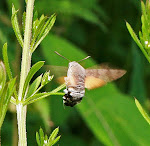North Wales is home to several species of damselfly which are of restricted or otherwise southern distribution in Britain. Sites for two of these were visited today. One, near Pendrhyndeudraeth, is a beautiful small lake known to have a rich Odonata fauna of which the Small Red Damselfly (Ceriagrion tenellum) is a speciality. This species occurs in a limited area of the lake margin where it favours the rather unstable raised acidic bog. Today there were large numbers of Large Red Damselflies (Pyrrhosoma nymphula) flying and it took a long period of searching before two individuals of the Small Red were found.

[Small Red Damselfly, male, all red body and red legs, near Pendrhyndeudraeth]
They differ from the black-legged Large Reds in having a completely red abdomen and reddish legs and are also smaller and more delicate. Also flying here were Common Blue and Common Blue-tailed Damselflies as well as Four-spotted Chasers and Keeled Skimmers (photos below).
Later, I made a visit to a second small lake within this general area to look for Scarce Blue-tailed Damselflies (Ischnura pumilio). This was near Llanrwst, a known locality and another idyllic site. A delay due a puncture meant arrival here was very late in the afternoon and for a while nothing at all was seen but eventually some movement in the lakeside vegetation revealed a single male pumilio and later two orange immature females.

[Scarce Blue-tailed Damselfly, immature female, aurantiaca phase, near Llanrwst]

[Scarce Blue-tailed Damselfly, male, near Llanrwst]
The immature females are often very brightly coloured (forma aurantiaca) and therefore easily identified. The males though are much more difficult being very similar to the Common Blue-tailed (Ischnura elegans). It is best differentiated from this by having segment 9 of its abdomen coloured blue with only a little blue on segment 8 whereas segment 9 of the Common blue-tailed is black and segment 8 is blue. Consequently, a close view or a good photograph is necessary in order to be completely sure.


[Large Red Damselflies (note the black legs), near Pendrhyndeudraeth]

[Four-spotted Chaser, near Pendrhyndeudraeth]

[Keeled Skimmer, near Pendrhyndeudraeth]
.jpg)

























